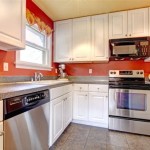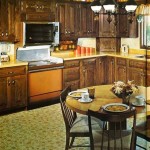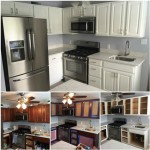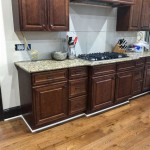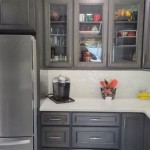How To Fit Kitchen Unit Door Hinges
Fitting kitchen unit door hinges is a fundamental skill for both DIY enthusiasts and professional carpenters. Proper installation ensures doors swing smoothly, align correctly, and remain securely attached to the cabinet frame. This article provides a comprehensive guide to understanding different types of hinges, accurately marking hinge positions, and securely installing them into kitchen unit doors and frames.
Before commencing any hinge installation, it is crucial to understand the different types of hinges commonly used in kitchen cabinetry. Each type offers distinct functionality and installation requirements. The selection of the appropriate hinge should align with the door style and the desired opening angle.
Concealed hinges, also known as European hinges, are the most prevalent type in modern kitchens. They are typically adjustable in multiple directions, allowing for precise door alignment. These hinges are mortised into both the door and the cabinet frame, concealing the hardware when the door is closed, providing a clean and contemporary aesthetic. Concealed hinges are available in various opening angles, including 95-degree, 110-degree, 165-degree, and even wider, catering to diverse design preferences and accessibility requirements. Face frame hinges are designed for cabinets with a face frame around the opening, while frameless hinges are designed for cabinets that do not have a face frame.
Butt hinges are a traditional option consisting of two rectangular leaves joined by a pin. One leaf is mortised into the door edge, while the other is mortised into the cabinet frame. Butt hinges are often used for inset doors, where the door sits flush with the cabinet frame. They require precise mortising to ensure proper alignment and smooth operation. They are generally less adjustable than concealed hinges.
Overlay hinges, often surface-mounted, are characterized by the door overlapping the cabinet frame. These hinges are relatively easy to install, as they do not usually require mortising, but they offer less adjustability compared to concealed hinges. They are available in various overlay dimensions to accommodate different door thicknesses and frame designs.
Piano hinges, also known as continuous hinges, run almost the entire length of the door and cabinet frame. They provide exceptional support and are frequently used for heavy doors or in applications requiring high durability. Piano hinges are typically surface-mounted and secured with numerous screws along their length.
Once the appropriate hinge type has been selected, the next crucial step involves accurately marking the hinge positions on both the door and the cabinet frame. Precise marking is essential for ensuring proper door alignment and smooth operation. The following steps outline the marking process for concealed hinges, which are the most common type used in kitchens.
The first step involves determining the hinge placement. Standard practice dictates placing hinges approximately 3-5 inches from the top and bottom of the door. For taller or heavier doors, additional hinges may be required to provide adequate support. Consider the weight and size of the door when determining the optimal number and placement of hinges.
Using a measuring tape and a pencil, accurately measure and mark the center point of each hinge location on the door's edge. Ensure the marks are perpendicular to the edge and consistently spaced. Double-check the measurements to avoid errors.
Position the hinge cup (the part that fits into the door) on the marked location. Trace around the perimeter of the hinge cup with a sharp pencil. This will define the area that needs to be mortised to accommodate the hinge cup. Use a hinge-mortising template for accuracy if available.
Using a square, extend the hinge placement marks from the door edge onto the cabinet frame. These marks will indicate where to attach the hinge plate (the part that attaches to the cabinet frame). Ensure the marks are aligned with the corresponding marks on the door.
Once the hinge positions have been accurately marked, the next step involves drilling pilot holes and installing the hinges. This process requires precision and attention to detail to ensure the hinges are securely attached and the door operates smoothly.
Drilling Pilot Holes
Before installing the hinges, it's essential to drill pilot holes for the screws. Pilot holes prevent the wood from splitting and make it easier to drive the screws straight. The size of the pilot hole will depend on the size of the screws being used. Refer to the screw manufacturer's recommendations for the appropriate drill bit size.
For the hinge cup, use a Forstner bit or a multi-spur bit to create a clean, flat-bottomed hole. The diameter of the bit should match the diameter of the hinge cup. Carefully drill to the correct depth, ensuring not to drill through the door. Test-fit the hinge cup to verify the depth.
For the screw holes in the hinge plate and the hinge cup, use a drill bit slightly smaller than the screw diameter. Drill pilot holes at each marked location. Ensure the pilot holes are straight and perpendicular to the surface.
Installing the Door Hinges
After drilling the pilot holes, carefully align the hinge cup with the mortised hole in the door and the hinge plate with the marked location on the cabinet frame. Ensure the hinges are oriented correctly, with the hinge pin facing the correct direction.
Insert screws into the pilot holes and tighten them securely. Start by tightening the center screw first, then the remaining screws. Avoid overtightening the screws, as this can strip the threads or damage the wood. Use a hand screwdriver for better control and feel. If using a power drill, set it to a low torque setting.
Once the hinges are installed, test the door's operation. Open and close the door slowly and check for any binding or misalignment. If the door does not swing smoothly, adjust the hinges as needed until the door operates freely.
Adjusting Concealed Hinges for Proper Alignment
Concealed hinges offer multiple adjustment options, allowing for precise door alignment. Common adjustments include side-to-side, up-and-down, and in-and-out adjustments.
Side-to-side adjustments are typically made by turning a screw located on the hinge arm. This adjustment allows you to move the door left or right, aligning it with the surrounding cabinet doors. Adjust the screw until the door is properly aligned horizontally.
Up-and-down adjustments are usually made by loosening the screws that secure the hinge plate to the cabinet frame. Slightly loosen the screws and reposition the hinge plate up or down as needed. Once the door is at the desired height, retighten the screws securely. Some concealed hinges have a dedicated screw for vertical adjustment.
In-and-out adjustments control the overlay of the door. This adjustment is typically made by turning a screw located on the hinge cup. Turning the screw will move the door closer to or further away from the cabinet frame, adjusting the reveal. Adjust the screw until the door overlay is consistent with the other doors in the kitchen.
After making each adjustment, test the door's operation to ensure it swings smoothly and aligns correctly. Repeat the adjustment process as needed until the door is perfectly aligned.
Troubleshooting Common Hinge Problems
Even with careful installation, occasionally issues may arise. These can typically be resolved with a few simple troubleshooting steps.
If the door binds or rubs against the cabinet frame, it may be misaligned. Check the hinge adjustments and make any necessary corrections to align the door properly. Ensure the cabinet frame itself is square and plumb.
If the screws are loose or stripped, they may not be holding the hinge securely. Replace the stripped screws with longer or wider screws. If the screw holes are damaged, use wood glue and toothpicks to fill the holes, then redrill pilot holes for the new screws.
If the door sags or droops, it may be overloaded. Add an additional hinge to provide more support. Ensure the hinges are properly rated for the weight of the door.
If the hinges are noisy, they may need lubrication. Apply a small amount of silicone lubricant to the hinge pin and moving parts. Avoid using oil-based lubricants, as they can attract dust and dirt.
If a hinge breaks, replace it with an identical hinge. Be sure to match the hinge type, size, and overlay. Follow the installation instructions provided in this guide to install the new hinge properly.
By following these guidelines and paying close attention to detail, homeowners can successfully fit kitchen unit door hinges, ensuring proper door alignment, smooth operation, and long-lasting durability. Regular maintenance, including tightening loose screws and lubricating moving parts, will further extend the lifespan of the hinges and ensure optimal performance.

How To Fit Or Replace A Kitchen Hinge

How To Adjust Your Kitchen Cabinet Hinges Solid Wood Cabinets Information Guides

How To Install Cabinet Hinges A Step By Guide

Guide To Drilling Hinge Holes In Kitchen Doors Tips Tricks

Installing Concealed Cabinet Door Hinges Handles The Easy Way

How To Adjust Your Kitchen Cabinet Hinges Solid Wood Cabinets Information Guides

How To Install Overlay Kitchen Cabinet Hinges Roots Wings Furniture Llc

How To Adjust Your Cabinet Door Hinges Properly

How To Install Overlay Kitchen Cabinet Hinges Roots Wings Furniture Llc

How To Measure Hinges For Kitchen Doors Kdh
Related Posts

